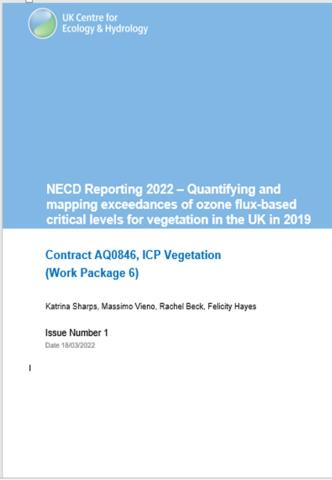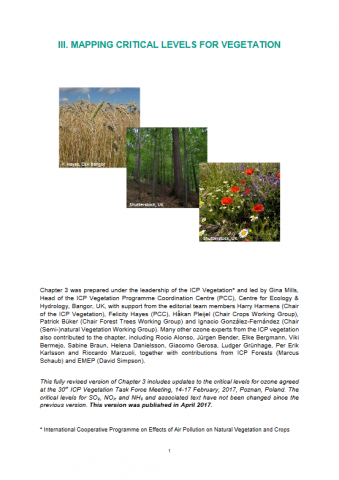Bibliography
.
2008. Challenges in understanding the risks to natural and semi-natural vegetation from ozone exposure. Italian Journal of Agronomy. 3:53-59.
.
2018. Closing the global ozone yield gap: Quantification and co-benefits for multi-stress tolerance.. Global Change Biology. (Not yet assigned to an issue)
.
2015. Comments on JA Fernandez, MT Boquete, A. Carballeira, JR Aboal (2015). A critical review of protocols for moss biomonitoring of atmospheric deposition: Sampling and sample preparation. Science of the Total Environment 517: 132-150. Science of the Total Environment. 538:1024-1026.
.
2009. A comparison of North American and Asian exposure-response data for ozone effects on crop yields. Atmospheric Environment. 43:1945-1953.
.
2013. Correlation between atmospheric deposition of Cd, Hg and Pb and their concentrations in mosses specified for ecological land classes covering Europe. Atmospheric Pollution. 4:267-274.
.
2012. Country-specific correlations across Europe between modelled atmospheric cadmium and lead deposition and concentrations in mosses. Environmental Pollution. 166:1-9.
.
2018. Current surface ozone concentrations significantly decrease wheat growth, yield and quality.
.
2011. Evidence of widespread effects of ozone on crops and (semi-)natural vegetation in Europe (1990-2006) in relation to AOT40-and flux-based risk maps. Global Change Biology. 17:592-613.
.
2010. First Europe-wide correlation analysis identifying factors best explaining the total nitrogen concentration in mosses. Atmospheric Environment. 44:3485-3491.
.
2009. First thorough identification of factors associated with Cd, Hg and Pb concentrations in mosses sampled in the European Surveys 1990, 1995, 2000 and 2005. Journal of Atmospheric Chemistry. 63:109-124.
.
2014. Have ozone effects on carbon sequestration been overestimated? A new biomass response function for wheat Biogeosciences. 11:4521-4528.
.
2015. Heavy metal and nitrogen concentrations in mosses are declining across Europe whilst some "hotspots" remain in 2010. Environmental Pollution. 200:93-104.
.
2007. Identifying ozone-sensitive communities of (semi-)natural vegetation suitable for mapping exceedance of critical levels. Environmental Pollution. 146:736-743.
.
2006. Impacts of summer ozone exposure on the growth and overwintering of UK upland vegetation. Atmospheric Environment. 40:4088-4097.
.
2007. Implications of climate change for the stomatal flux of ozone: A case study for winter wheat. Environmental Pollution. 146:763-770.
.
2011. Limited potential of crop management for mitigating surface ozone impacts on global food supply. Atmospheric Environment. 45:2569-2576.
.
2014. Mapping correlations between nitrogen concentrations in atmospheric deposition and mosses for natural landscapes in Europe. Ecological Indicators. 36:563-571.
.
2007. Meta-analysis of the relative sensitivity of semi-natural vegetation species to ozone. Environmental Pollution. 146:754-762.
.
2008. Metal accumulation in mosses across national boundaries: Uncovering and ranking causes of spatial variation. Environmental Pollution. 151:377-388.
.
2010. Mosses as biomonitors of atmospheric heavy metal deposition: Spatial patterns and temporal trends in Europe. Environmental Pollution. 158:3144-3156.
.
2011. New stomatal flux-based critical levels for ozone effects on vegetation. Atmospheric Environment. 45:5064-5068.
.
2011. Nitrogen concentrations in mosses indicate the spatial distribution of atmospheric nitrogen deposition in Europe. Environmental Pollution. 159:2852-2860.
.
2020. Organochlorines burden in moss H. cupressiforme and topsoil across Serbia. Environmental Geochemistry and Health.
 ]
] 
